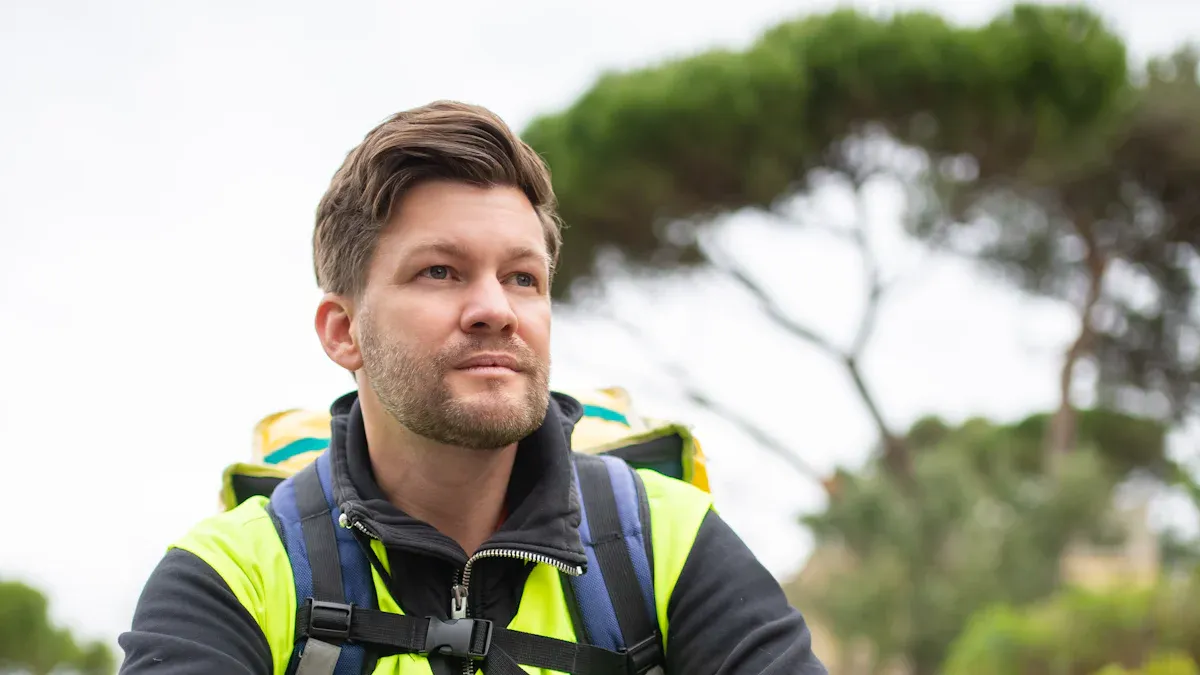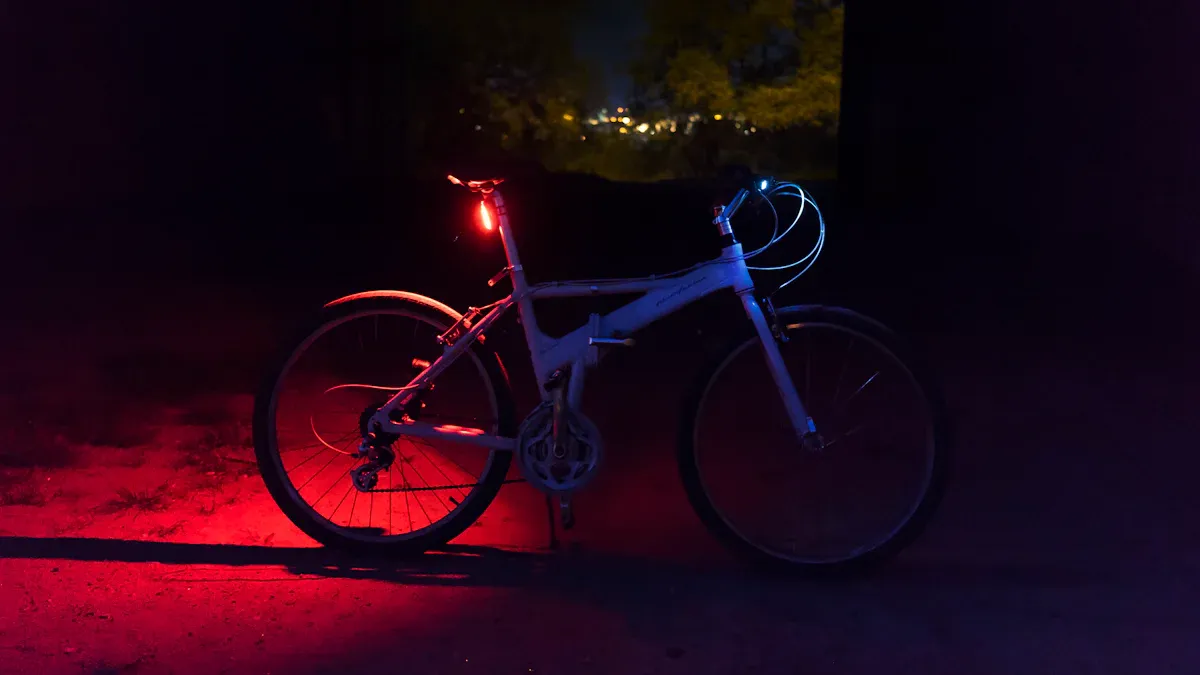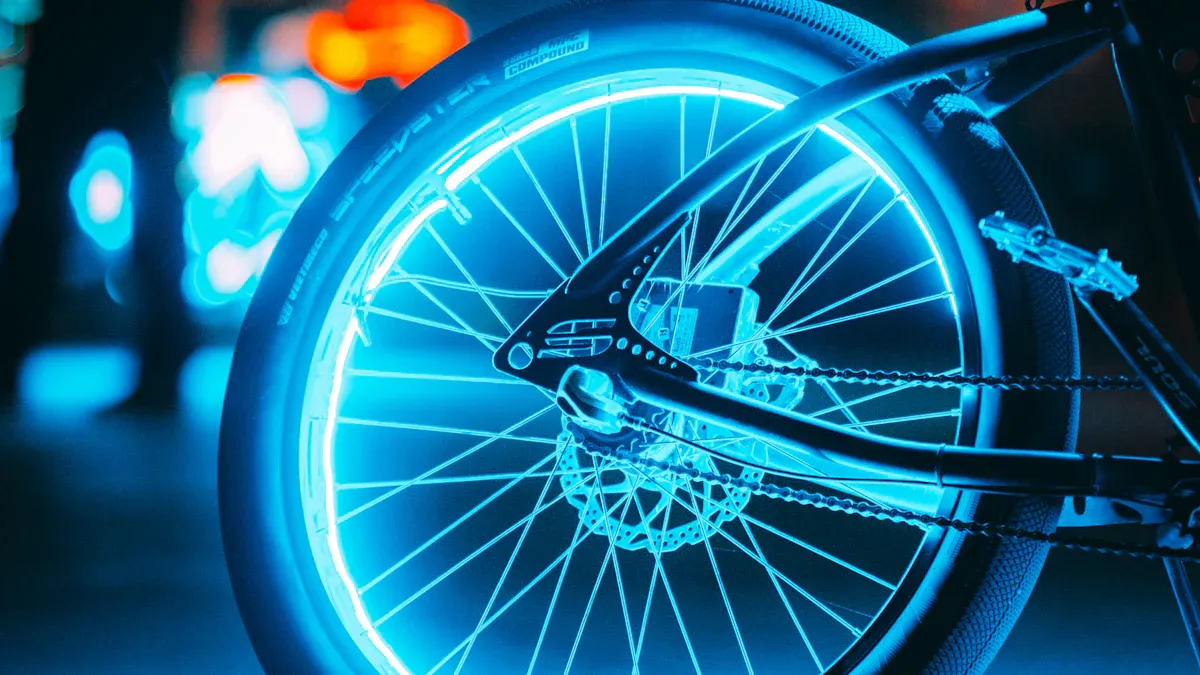The Best Ways to Stay Visible at Night While Cycling or Walking

Staying visible at night is essential for your safety. Low visibility increases the risk of accidents, especially when cycling or walking. Reflective clothing, like jackets or ankle straps, can make you stand out. Adding lights to your bike or wearing a headlamp also helps drivers see you clearly, keeping you safer.
Key Takeaways
Put on reflective clothes and gear to be seen better. This easy step lowers the chance of accidents at night.
Attach bright LED lights to your bike and equipment. These lights help others see you and let you spot dangers.
Pick routes with good lighting for walking or biking. Well-lit paths make it easier to see risks and stay safe.
Why Visibility Is Crucial at Night
Risks of low visibility for cyclists and pedestrians
When you're out cycling or walking at night, low visibility can put you at serious risk. Darkness makes it harder for drivers to see you, especially if you're not wearing reflective gear or using lights. Weather conditions like fog or rain can make things even worse, reducing visibility even further. On top of that, drivers may feel tired or distracted, which slows their reaction time. Glare from headlights can also temporarily blind them, making it harder to spot you in time.
Tip: Always assume drivers might not see you and take extra steps to make yourself visible.
Common causes of nighttime accidents
Nighttime accidents involving pedestrians and cyclists often happen because of reduced visibility. Statistics show that most pedestrian fatalities occur during the night, even though there’s less traffic. Drivers are supposed to be cautious, but negligent behavior like speeding, distracted driving, or driving under the influence (DUI) often leads to accidents. Failing to yield to pedestrians or cyclists is another common issue.
If you're walking or cycling at night, you need to be proactive about your safety. Wearing reflective clothing or using lights can make a big difference in helping drivers notice you.
How visibility reduces accident risks
Enhanced visibility is one of the best ways to stay safe at night. Reflective gear and lights make you stand out, giving drivers more time to react. Studies show that better bicycle visibility and reflective clothing significantly reduce the chances of accidents. Even in low-traffic areas, staying visible can save lives.
Choosing well-lit routes and using high-visibility gear can also improve your safety. When you make yourself easy to spot, you’re not just protecting yourself—you’re helping drivers avoid accidents too.
Tools to Enhance Visibility

Using flashlights and headlamps
Using a flashlight or a headlamp is one of the simplest ways to stay visible at night. A flashlight not only lights up your path but also signals your presence to others. Headlamps, on the other hand, keep your hands free, making them perfect for cycling or walking. They’re especially useful when navigating uneven terrain or poorly lit areas.
Tip: Always point your flashlight or headlamp slightly downward to avoid blinding others.
When you’re using a flashlight, make sure it’s bright enough to illuminate your surroundings. LED flashlights are a great choice because they provide better illumination and consume less energy.
Benefits of reflective clothing and accessories
Reflective clothing is a game-changer for nighttime safety. Items like vests, armbands, and ankle straps reflect light from car headlights, making you more visible to drivers. Pairing reflective gear with bright clothing, such as neon colors, enhances your visibility even further.
Material Type | Description | Visibility Range |
|---|---|---|
Microprismatic Reflective | Made from tiny prisms that reflect light, providing high reflectivity and durability. | Efficient light reflection |
Diamond Grade Reflective | High-intensity prismatic and diamond-grade materials for superior visibility. | |
High-Intensity Prismatic | Visible up to 1,000 feet, ideal for extreme conditions. | Up to 1,000 feet |
Investing in reflective clothing gives you confidence when you’re out at night, knowing you’re easier to spot.
High-visibility gear for cycling and walking
High-visibility gear is essential for cyclists and pedestrians. Brightly colored jackets, backpacks, and helmets with reflective elements can make a huge difference. For cyclists, adding a front light and rear light to your bicycle is crucial. These lights not only improve your visibility but also help you see obstacles ahead.
Note: A rear light is especially important for alerting drivers approaching from behind.
Adding lights to bikes, backpacks, or clothing
Adding lights to your gear is another effective way to enhance visibility. Clip-on LED lights can be attached to your backpack, shoes, or even your clothing. These small but powerful lights make you stand out, especially in low-light conditions.
For cyclists, a front light and rear light are non-negotiable. A bright front light illuminates your path, while a flashing rear light grabs the attention of drivers.
LED lights for enhanced nighttime safety
LED lights are a top choice for nighttime safety. They’re brighter than traditional lights and offer longer beam coverage. This means you can see hazards sooner and react faster. LED lights also mimic daylight, making it easier for your eyes to adjust.
Fun Fact: LED lights consume less energy and last longer, making them an eco-friendly option for nighttime activities.
Whether you’re cycling or walking, LED lights provide enhanced visibility and peace of mind.
Safe Practices for Nighttime Activities

Choosing well-lit and safe routes
When planning your nighttime walks or cycling trips, always prioritize well-lit and safe routes. Streetlights and illuminated paths improve your visibility and help you spot hazards like uneven sidewalks or debris. Avoid shortcuts through dark alleys or poorly lit areas, as these can increase the risk of accidents. If you're cycling, stick to designated bike lanes or paths where drivers expect to see cyclists.
Tip: Use apps or maps to find routes with good lighting and minimal traffic for added safety and increased confidence.
Following road rules and pedestrian guidelines
Staying safe at night means following basic road rules and pedestrian guidelines. Here are some key practices to keep in mind:
Stay on designated walkways to reduce the risk of accidents.
Avoid distracted walking, like texting or looking at your phone.
Be mindful of weather conditions that might reduce visibility.
Use reflective tape on your clothing or gear for enhanced visibility.
Avoid wearing dark clothing, as it makes you harder to see.
Use hand signals to communicate your intentions to drivers.
These simple steps can make a big difference in keeping you safe during nighttime walks or cycling.
Proper flashlight handling and signaling
Choosing the right flashlight is crucial for nighttime safety. A bright flashlight not only lights your path but also signals your presence to others. When walking or cycling, point your flashlight slightly downward to avoid blinding others. If you're cycling, consider attaching a front light to your bicycle for better visibility.
Use your flashlight to signal your intentions when crossing streets or navigating traffic-heavy areas. For example, a quick wave of light can alert drivers to your presence. This small action can prevent accidents and give you increased confidence while out at night.
Staying alert and avoiding distractions
Staying alert is one of the most important safety practices for nighttime activities. Avoid distractions like looking at your phone or texting while walking. These habits impair your night vision and make it harder to notice hazards. Texting while walking can also delay your reaction time, increasing the risk of accidents.
Keep your focus on your surroundings, especially in traffic-heavy areas. Listen for approaching vehicles and watch for any sudden movements. Staying alert helps you react quickly to potential dangers, ensuring a safer experience during nighttime walks or cycling.
Staying visible at night is essential for your safety. Here’s why:
Clean windshields and working headlights improve visibility for drivers.
Reflective gear and lights help you stand out in low light.
Investing in quality tools saves money and ensures safety long-term.
Make visibility your priority. It’s a small step that makes a big difference.
FAQ
How can I check if my gear is visible enough at night?
Test your gear by shining a flashlight on it in a dark room. Reflective materials should glow brightly under the light.
Tip: Ask a friend to observe you from a distance to ensure you're noticeable.
Are flashing lights better than steady lights for visibility?
Yes, flashing lights grab attention faster than steady ones. Use a combination of both for maximum visibility and safety.
What’s the best way to stay visible in bad weather?
Wear waterproof reflective gear and use bright LED lights. These tools work well in rain or fog, ensuring you remain visible to others.
Note: Avoid dark clothing, as it blends into low-light conditions.
See Also
Essential Tips for Using Your CYANSKY Camping Flashlight
Guide to Utilizing the CYANSKY HS6R Headlamp Effectively
Enjoy Night Fishing with a Convenient Headlamp Flashlight
Advantages of Employing a Red Light Headlamp Outdoors
Why Rechargeable Flashlights Are Essential for Public Safety
